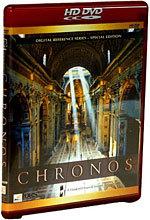Chronos
Overview -Taking the familiar conventions of time-lapse cinematography to a transcendent level of artistic achievement, filmmaker Ron Fricke circled the globe to make Chronos, a stunning 70-millimeter time-lapse tour of natural and man-made wonders. The entire film has the enhanced, hyper-realistic quality of a laser-etched photograph, and by using special cameras and motion-control photographic techniques, Fricke and his technically expert crew were able to create mesmerizing images guaranteed to spark any viewer's sense of awe and wonder. Accompanied by the hypnotic music of Michael Stearns, this visual journey takes the viewer on a tour of over 50 locations on nearly every continent of the world, including explorations of Paris, the Vatican, the Egyptian pyramids, the African veldt, and many more stunning vistas. The cumulative effect is the feeling that the world--from the busiest metropolis to the most serenely remote wilderness landscape--is dictated by "chronos," the rhythm of time to which all living things must submit. Like Koyaanisquatsi and Baraka, this is one of those eye-candy films that was conceived according to its specific theme, so it's not only a soothing visual experience but a thought-provoking study of our fascinating planet.
Storyline: Our Reviewer's Take

"A hallmark title in the canon of special venue film presentations, 'Chronos' imparts a unique vision of our world -- the first non-verbal, non-fiction motion picture filmed in time-lapse photography, scored with exotic instrumentation in a multi-channel surround soundtrack. Presented as a visual symphony in seven movements, 'Chronos' embarks on an unprecedented cinematic journey across the worlds of natural beauty and manmade monuments, as it explores the essence of time."
So says the synopsis on the back of the box for 'Chronos,' which is the first IMAX film to debut on HD DVD. But what exactly is this movie about? The closest comparison I can come up with is the 'Koyaanisqatsi' trilogy, which are meditative, sometimes bombastic collisions of images and music that, through montage and juxtaposition, are meant to inspire us to see our world in new and challenging ways. If that sounds a bit high-falutin' and artsy-fartsy, well, it is. And while 'Chronos' may not match the ingenuity and pure visual brilliance of the "Qatsi" films, it still achieves a good number of its own moments of beauty and grandeur.
Documentarian Ron ('Baraka,' 'The Living Sea') Fricke made his directorial debut with 'Chronos' after working for years as a cinematographer, most notably on (wait for it) 'Koyaanisqatsi.' Despite a surprisingly limited budget, compressed shooting schedule and then-developmental IMAX camera equipment, Fricke clearly surmounted those obstacles to produce a work that is often visually breathtaking. Striking images abound in 'Chronos' -- burning orange suns caressing the decaying ruins of Egypt, a steel blue moon rising over a gleaming cityscape, misty-gray low tides consuming a rocky shoreline in England. If these images, on their own, appeear to have no inherent "meaning," in the moments that I absorbed them, I didn't care. There is no use in arguing with natural beauty -- just take a deep breath and dive in.
If the sum of 'Chronos' ultimately feels like less than its parts, that may because unlike the 'Qatsi' films, Fricke and his sonic collaborator, Michael Stearns, seem to have no agenda in marrying their images and music. Nor does Fricke have any apparent desire to impart any underlying social message with his mise-en-scene. As beautiful as they may be, his juxtapositions and pastiche of natural and manmade landscapes seem arbitrary. Any and all interpretation is left to the viewer. The Vangelis-esque score is less reminiscent of Philip Glass than it is Yanni on acid. And with a runtime of only 40 minutes, 'Chronos' feels more like a long short film than a self-contained work. But it is no coincidence that the word "chronos" in Greek means "time." It seems to me that if 'Chronos' has anything to say at all, it is that time is all we have. And every moment is too precious to waste.
Video Review
I have to hand it to Koch Releasing, an indie distributor new to the next-gen scene that are making their HD DVD debut with 'Chronos.' They have included a four-page, full-color fold-out inside the packaging, and it contains perhaps the most comprehensive tech specs of any next-gen title I've seen. Everything (down to the kilohertz and bitrate of the audio commentary track) is listed in fine detail. So from us tech geeks to you, Koch, kudos.
Anyway, perusing the video encode specs, 'Chronos' is presented at an "average BR rate of 20.00/1920x1080i @ 29.976 with a 2:3 pull down using a proprietary process to assure the stream is complaint for HD DVD." Whew! In other words, a 1.78:1 widescreen (reformatted from the original IMAX exhibition of 4:3) transfer in 1080i video, and though it is the one spec not listed in the packaging, the codec is MPEG-2. (Note that a subsequent Blu-ray version released in early 2007 features a remastered 1080p transfer. We found it to be superior, so you may want to consider that version before investing in this HD DVD.)
Gobbledygook aside, the only problem here is that the source material does suffer from age -- originally produced in 1987, 'Chronos' is fast approaching its twentieth birthday. The good news is that the source print is generally clean from major defects, such as scratches and obvious blemishes. However, grain is present throughout, and it is heavy enough to be noticeable. There are also some surprising bits of dirt on select shots. For example, there is a short series of images of Egyptian statues that suddenly appear marred by splotches and the like. To be fair, some of these "dropouts" are actually birds and other physical elements (at mentioned it the commentary), but the print is still not pristine.
Audio Review
R&B certainly did not skimp on the audio options. DTS-HD (96/24 @ 2.046kbps) and Dolby Digital-Plus (48/24 @ 640kbps) 5.1 surround tracks are included, as well as a PCM (48/24 @ 1,540kbps) 2.0 stereo option. As there is no dialogue in the film, there are no subtitles.
I found it a bit strange that the PCM track is stereo only, although I know many audiophiles prefer 2.0 stereo mixes (or at least like the option). Personally, I found the DTS-HD to be superior to all. Michael Sterns' synthesizer-heavy score will not be to everyone's taste, but it certainly has a grand presence on this track. Dynamic range is very "bright," but that fits Stearn's choice of electronic instrumentation. High end remains clean and as pleasing as is possible, while low bass is deep enough that it has heft and presence but is not overpowering. The sense of presence to the rears is very effective, and often a "wall of sound" is created that is quite enveloping. Again, the score itself is an acquired taste, but pumped through a decent set of speakers, 'Chronos' can be a very immersive, wonderfully overpowering experience.
Special Features
'Chronos' hits HD DVD with a somewhat overhauled set of extras. Though I don't own the existing standard-def DVD release, a quick look at the disc's specs online confirms that all of the featurettes on that version have been dropped. Also missing is a "Director's Shot List," though most of the information there seems to have been replicated in new text features exclusive to the HD DVD (see the next section.)
The only feature directly ported over from the standard-def DVD release is the screen-specific audio commentary with director Ron Fricke, composer Michael Stearns and production manager Alton Walpole. Perhaps because the film only runs 40 minutes, I quite enjoyed this track. Though quite technical, it still feels somewhat breezy. None of the participants are pretentious, and there are some humorous stories of trying to get complex shots off in one take, including several times when the film almost ran out in the camera, or an image needed to look "foggy" so Fricke smoked "about fifty cigarettes" and blew them in front of the lens. My only lament is that Fricke never really discusses his shot selection or why he assembled images together the way he did; a bit more creative discussion would have been welcome.
Note that I did find the menu system a tad confusing at first. When you first boot up the disc, you are taken to the main menu, but there are only three options: "Play" the movie, get a list of "About" credits (mainly an IMDB listing for the filmmakers) and "DVD-ROM" instructions for accessing additional PC-only content on the disc. The only way to access the commentary and the other HD exclusive content (see below) is to start up the movie, and then hit the "Menu" button on your remote. That brings up a real-time interactive navigation bar during playback that grants control of the audio settings, chapter search and supplemental content.
'Chronos' is an interesting IMAX film. It may not be for everyone, but I found it soothing, thought-provoking, and at times breathtaking. R&B has done a respectable job with their maiden HD DVD release, though some may find fault with the transfer's source materials, which do suffer from age-related deficiencies. The disc's extras also lack the featurettes seen on the standard-def DVD version, which may dissuade those interested in upgrading their copy. Still, 'Chronos' is a unique enough film that it is worth at least checking out in high-def.











